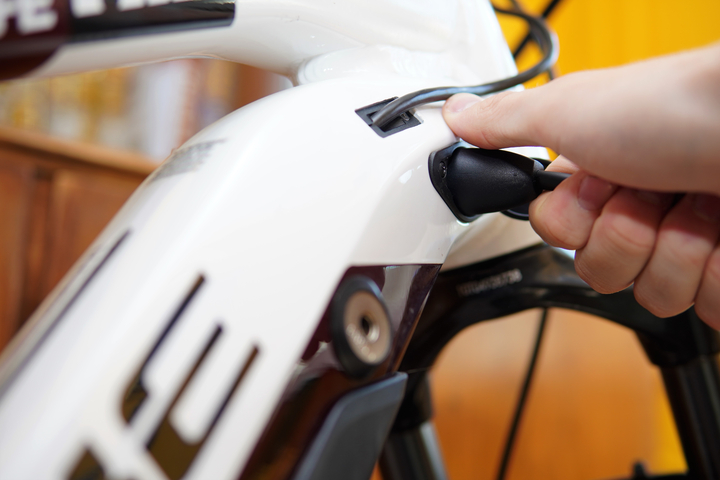The battery is the energy source of every pedal-assisted bike (pedelec), it supplies the electric motor with the necessary power to assist bike riding.
The eBike is the subject of many questions. What are the differences between batteries? How long does the battery last after charging? What needs to be taken into account for its storage?
Today, we answer eleven frequently asked questions about the eBike battery in the hope of satisfying your curiosity!
1. What characterizes lithium-ion batteries?
Lithium-ion batteries are among the most modern and common batteries for pedelecs. Due to their high energy density, they store more energy and have a lower weight. With an average weight of around 2.5 kg, they are among the lightest on the market and boast the highest energy density.
2. What’s the average life of a battery?
Lithium-ion batteries have a long service life. They are designed to last for many kilometres. The intelligent battery management system (BMS) protects them against high temperatures, overcharging and deep discharge. It’s not possible to forecast an exact durability, as it may depend essentially on type and length of use. We can consider an average of 400-500 charging-discharging cycles.
3. What factors affect the service life of the eBike battery?
To maximize the battery life, a few simple rules of care, transportation and proper storage should be observed. The battery should be stored in a dry, sunlight-free room at an ambient temperature of approx. 10 to 20 degrees Celsius. The ideal state of charge of the battery is between 30 and 60 per cent. Charging should ideally take place at room temperature. When transporting, always remove the battery pack from the eBike and store it in a safe area of the vehicle.
4. What’s the battery charge duration?
Charging time depends on the battery capacity.
Using the Bosch product as an example, the PowerPack 300, PowerPack 400 and PowerPack 500 take around one, one and a half and two hours respectively to be fully charged with the standard charger. A fully discharged PowerPack 300 can be fully charged in just two and a half hours. A PowerPack 400 takes 3.5 hours and a PowerPack 500 4.5 hours.
5. How much runtime does the battery have after charging and why?
It is not always possible to give an exact answer. A battery charge can cover a range of less than 20 km to over 100 km. Many different factors influence the range:
- the level of support
- cyclist conduct
- air resistance
- cyclist’s weight
- tyre pressure
- the terrain
What are the ground conditions? Are we riding on an asphalt road, a country road or a mountain path? Does the route have a lot of climbs and inclines, or is it flat? All these variables affect the range of the battery.
If you have a Bosch system, we recommend that you look at www.bosch-ebike.com. There you will find an “Autonomy Assistant” which, taking various factors into account, calculates a stopping point based on the number of kilometers that can be covered in the given conditions.
6. What do you have to be careful of in Winter?
Normally, cold temperatures reduce battery performance. When the eBike is used in Winter at temperatures below 0° C, it’s advisable to put the battery in the eBike only once it has been charged and kept at room temperature, and right before starting the journey. If the eBike is not used for a certain period of time, the battery pack should be stored in a cool, dry place with a charge of between 30 and 60 percent of its capacity.
7. How should the battery be properly cared for?
In order to protect the electronic components, a high-pressure cleaner is not advised. We recommend cleaning the battery with a damp cloth. Avoid aggressive cleaning agents. Before cleaning the eBike, the battery pack must be removed. From time to time, it is also useful to clean and lightly lubricate the eBike connector pins.
8. What’s the correct charging procedure?
Batteries with lithium-ion cells can be briefly charged, regardless of their current state of charge. The battery management system protects the battery against overcharging. Interrupting the charging process does not damage the battery. Important note: eBike batteries may only be charged with the respective charger. Otherwise, they can be irreversibly damaged (among other things, invalidating the warranty).
9. How often can batteries be charged?
The best batteries still have a high capacity after 500 full charges (between 60 and 70 per cent).
According to a test carried out by ADAC in the autumn of 2015, a Bosch battery could be discharged and fully recharged up to 1,515 times; it then only had 30 percent of its original capacity and could no longer be used. What does that mean? That this battery would have been sufficient to cover up to 57,000 kilometers, or one and a half times the circumference of the Earth.
10. Where can batteries be repaired?
High quality ion-lithium batteries are high precision complex systems and their repair requires special technical expertise. Our laboratory is equipped with modern testing and control systems. If you need assistance, please proceed as follows: send us an email with a photo of the battery type and a description of the problem. We will contact you quickly and tell you whether an inspection is possible or whether a replacement is necessary.
11. How can batteries be disposed of?
The specialist retailer must ensure that the battery is disposed of ecologically and free of charge. This is done by means of the “common battery collection system”, which among other things allows valuable materials to be recovered in the raw material circuit, protecting our resources and the environment.
